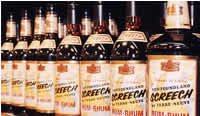Mummering & Other Customs
Exerpts from the Newfoundland and Labrador Heritage website.

 When people think of Newfoundland customs, the first that springs to mind is Christmas mummering; however, Newfoundland has many customs that are
similar to those in other provinces and countries, with twists that make them unique to the Island.
When people think of Newfoundland customs, the first that springs to mind is Christmas mummering; however, Newfoundland has many customs that are
similar to those in other provinces and countries, with twists that make them unique to the Island.
Pancake Night, or Shrove Tuesday, is a typical Newfoundland custom. Derived from widespread customs in European traditions, and shaped as much by religious beliefs as by traditional divinational activities, it is a mixture of traditions, evolving continuously. Shrove Tuesday (named for the religious practice of confessing one's sins and being "shriven" or "shrove" by the priest immediately before Lent began) was a time to use up as many as possible of the foods banned during Lent: meat products in particular, including butter and eggs. Pancakes were a simple way to use these foods, and one that could entertain the family. Objects with symbolic value are cooked in the pancakes, and those who eat them, especially children, take part in a divinatory game as part of the meal. The person who receives each item interprets the gift according to the tradition: a coin means the person finding it will be rich; a pencil stub means he/she will be a teacher; a holy medal means they will join a religious order; a nail that they will be (or marry) a carpenter, and so on.
Midsummer's Day can be traced back to European traditions before the advent of Christianity. One of its modern forms is St John's Day, a thoroughly Christianized name. Now merely a municipal holiday in St John's, it was formerly called Discovery Day, one of the national holidays of Newfoundland. Its roots go back through the bonfire celebrations that are still made on the Southern Shore of the Avalon Peninsula (as well as some other predominantly Irish-settled communities in Conception Bay). These fire customs are as old as, or even older than, the Guy Fawkes Night bonfires in early November. In the 1940s the Newfoundland Government instituted a holiday on June 24th to celebrate Newfoundland's history. The day was removed from the calendar by the provincial government in the late-1980s.
 Memorial Day now conflicts with the celebration of Canada Day. It was established soon after the tragically destructive events of July 1st 1916, the opening day of the Battle of the Somme, when hundreds of Newfoundland soldiers lost their lives at the battle of Beaumont-Hamel. Each year since, commemorative parades and memorial services have been held on the Sunday nearest July 1st.
Memorial Day now conflicts with the celebration of Canada Day. It was established soon after the tragically destructive events of July 1st 1916, the opening day of the Battle of the Somme, when hundreds of Newfoundland soldiers lost their lives at the battle of Beaumont-Hamel. Each year since, commemorative parades and memorial services have been held on the Sunday nearest July 1st.
Throughout Newfoundland, churches have held Garden Parties to raise funds for local parishes or for special projects. On some designated day, usually a Sunday when fewer people would be working, a day-long party is held outdoors, if the weather is fine, or in the church hall, if not. With wheels of fortune, and races in the afternoon, meals served at suppertime, and a dance at night, the festivities would continue for hours. In recent years the organization of such community-wide parties has frequently devolved to town councils, and a weekday often in early August has been set aside. In some larger towns the garden party became a regatta - Harbour Grace, Placentia and St John's are three examples. The St John's Regatta is the largest of these garden-parties-become-regattas; on the first Wednesday in August (or the first fine day thereafter), the city stops working and attends the boating races on Quidi Vidi Lake. Upwards of 30,000 attend every year, with estimates in some years of over 50,000 people attending the day-long event.
 Bonfires on November 5th in commemoration of the death of the anti-Parliamentary terrorist Guy Fawkes are still carried out every year in hundreds of communities around the province. Most present-day participants in the fires would be hard-pressed to say who Guy Fawkes was, and the custom mainly functions to help clean up communities.
Bonfires on November 5th in commemoration of the death of the anti-Parliamentary terrorist Guy Fawkes are still carried out every year in hundreds of communities around the province. Most present-day participants in the fires would be hard-pressed to say who Guy Fawkes was, and the custom mainly functions to help clean up communities.
The season of Christmas is often said to be twelve days long, and ends for most people on "Old Christmas Day," January 6th. This date is liturgically the Feast of the Epiphany and signals the beginning of the third part of the church's Christmas season (Advent, Christmas proper and Epiphany). The comparatively recent name "Old Christmas" stems from the 1752 reorganization of the calendar when twelve days were dropped from the calendar; the following year, purists said that the "real" Christmas Day was not on December 25th, but January 6th, 365 days after the previous Christmas. The knowledge of the Old Style has led some Newfoundlanders to name "Old Old Christmas Day" (January 18th) as the "real" end of the season. Indeed mummering can sometimes be seen on the Southern Shore of the Avalon peninsula until the end of January.
 Mummering, the practice of disguising oneself and visiting from house to house, is carried on through the Christmas season. Known in Britain as "mumming," the name "mummering" long ago became usual in Newfoundland. It usually does not start until St Stephen's Day (known nowadays as Boxing Day, and falling on December 26th). Mummering is sometimes said to be a non-religious custom that should be carried on neither on Christmas Day itself, nor on Sundays during the season. Nonetheless, this is not a universal rule and one can find mummers out visiting even on Christmas Day.
Mummering, the practice of disguising oneself and visiting from house to house, is carried on through the Christmas season. Known in Britain as "mumming," the name "mummering" long ago became usual in Newfoundland. It usually does not start until St Stephen's Day (known nowadays as Boxing Day, and falling on December 26th). Mummering is sometimes said to be a non-religious custom that should be carried on neither on Christmas Day itself, nor on Sundays during the season. Nonetheless, this is not a universal rule and one can find mummers out visiting even on Christmas Day.
In the 1960s it was common for people to say that mummering was dying out. Indeed they pointed at the widespread use of carpets as the reason mummers were no longer welcome -- it was more difficult to clean up the mud and snow from carpet than it was from linoleum. But in the 1980s there was a sharp increase in the practice of mummering and at the end of the 1990s it appears the custom is as strong as it ever may have been.
Explanations of mummering have been many but the rule that the simplest explanation is the best suggests that theories of ancient rituals of sun worship, and devolution of mummers' play into the guising and visiting routine are probably wrong. The mummers' plays are traditional texts involving a short dramatic performance by six to twelve actors, playing the roles of King George, The Doctor, The Turkish Knight, and others. The traditional plays seem to have been no older than about 200 years and, in Newfoundland, were most popular in the second half on the nineteenth century. The traditions of guising and visiting, by contrast, seem to have been much older. One theory of the origin of the plays is that they were an effort by British lords of manors to contain and shorten the visits by peasantry. To some extent, this social role was carried over to Newfoundland by the encouragement of plays by school masters in some communities.
Birthday customs are as traditionally variable as other customs. Even though the term "bumps" is widely used, it does not refer to the same activity. In Newfoundland bumps usually refers to four people picking up the birthday child and bouncing their rump against the ground, once for each year and "one to grow on." In some other places bumps refers to the same number of kicks, slaps or "knees" in the thigh or buttocks.
In a few parts of Newfoundland, the southwest coast and the west coast in particular, the traditional birthday trick is what is often known as "grease face." The same custom is known in parts of the Maritime provinces of Canada as "buttered noses". As early as is convenient on the birthday someone tries to reach from behind the birthday boy or girl and dab on their nose a fingerful of grease, often butter. This is accompanied by best wishes for the year, now lubricated with the greasy face. Among schoolchildren this custom sometimes takes the form of pushing a sweet, creamy cake in the face.
 Perhaps the most controversial custom in Newfoundland in recent years is the Screech-In. It is historically related to such traditions as equatorial line-crossing and initiation rites known all over the world. It derives from "honorary Newfoundlanders" rites of the 1940s and pranks played on new sealers going to the ice. The Screech-In came into being in the 1970s when Joe Murphy and Joan Morrissey put together an entertainment at the Bella Vista Country Club in St John's. It included local musical performers and a dress-up skit by which members of the audience were humorously "screeched-in." In later years the Screech-In was widely performed by Myrle Vokey and by employees of the Newfoundland Liquor Commission. Typically, initiates are made to kiss a codfish, drink some Screech (rum) and repeat a semi-dialect, slightly risqué recitation.
Perhaps the most controversial custom in Newfoundland in recent years is the Screech-In. It is historically related to such traditions as equatorial line-crossing and initiation rites known all over the world. It derives from "honorary Newfoundlanders" rites of the 1940s and pranks played on new sealers going to the ice. The Screech-In came into being in the 1970s when Joe Murphy and Joan Morrissey put together an entertainment at the Bella Vista Country Club in St John's. It included local musical performers and a dress-up skit by which members of the audience were humorously "screeched-in." In later years the Screech-In was widely performed by Myrle Vokey and by employees of the Newfoundland Liquor Commission. Typically, initiates are made to kiss a codfish, drink some Screech (rum) and repeat a semi-dialect, slightly risqué recitation.
In 1990 the custom came under fire from several directions and was attacked as a destructive mocking of Newfoundland culture. The Premier at the time, Clyde Wells, ordered the Liquor Commission to destroy "Order of Screechers" certificates that bore his official signature. Nonetheless, the Screech-In has continued in the 1990s as a widely favoured way of welcoming visitors to Newfoundland with an entertaining ritual.
What children think of mummering.


